check engine light FIAT MULTIPLA 2006 1.G Owner's Manual
[x] Cancel search | Manufacturer: FIAT, Model Year: 2006, Model line: MULTIPLA, Model: FIAT MULTIPLA 2006 1.GPages: 266, PDF Size: 4.61 MB
Page 216 of 266
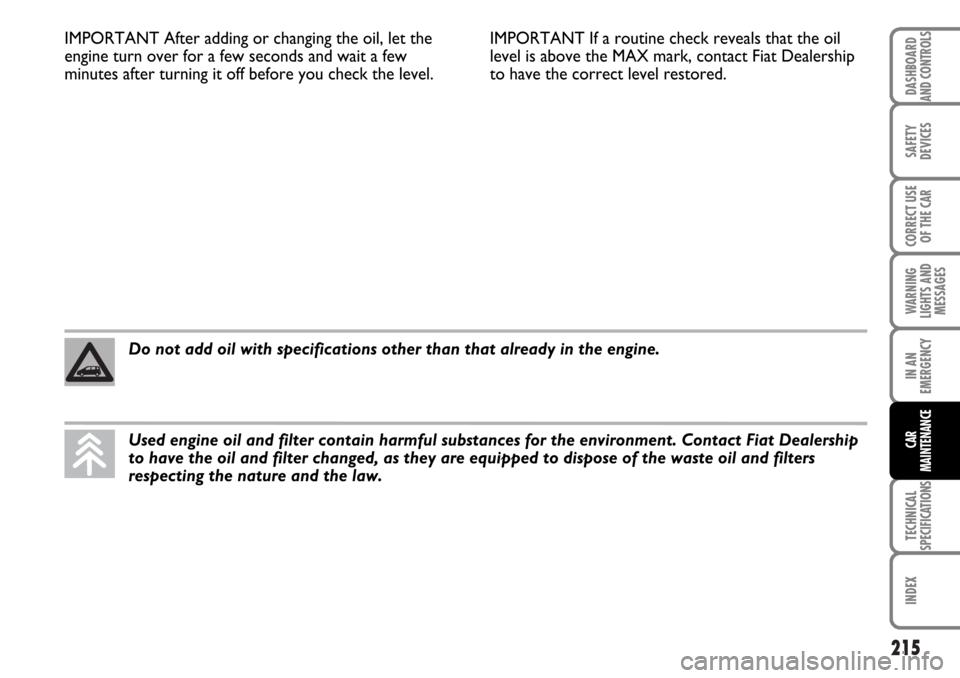
215
SAFETY
DEVICES
CORRECT USE
OF THE CAR
WARNING
LIGHTS AND
MESSAGES
TECHNICAL
SPECIFICATIONS
INDEX
DASHBOARD
AND CONTROLS
IN AN
EMERGENCY
CAR
MAINTENANCEUsed engine oil and filter contain harmful substances for the environment. Contact Fiat Dealership
to have the oil and filter changed, as they are equipped to dispose of the waste oil and filters
respecting the nature and the law. IMPORTANT After adding or changing the oil, let the
engine turn over for a few seconds and wait a few
minutes after turning it off before you check the level.
Do not add oil with specifications other than that already in the engine.
IMPORTANT If a routine check reveals that the oil
level is above the MAX mark, contact Fiat Dealership
to have the correct level restored.
Page 217 of 266
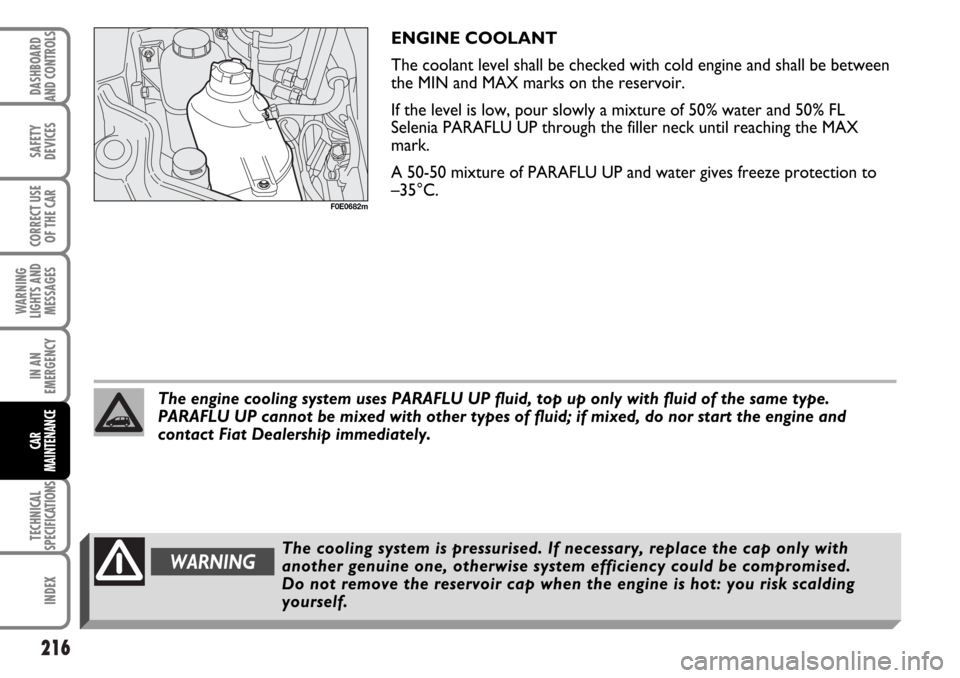
216
SAFETY
DEVICES
CORRECT USE
OF THE CAR
WARNING
LIGHTS AND
MESSAGES
IN AN
EMERGENCY
TECHNICAL
SPECIFICATIONS
INDEX
DASHBOARD
AND CONTROLS
CAR
MAINTENANCE
ENGINE COOLANT
The coolant level shall be checked with cold engine and shall be between
the MIN and MAX marks on the reservoir.
If the level is low, pour slowly a mixture of 50% water and 50% FL
Selenia PARAFLU UP through the filler neck until reaching the MAX
mark.
A 50-50 mixture of PARAFLU UP and water gives freeze protection to
–35°C.
F0E0682m
The engine cooling system uses PARAFLU UP fluid, top up only with fluid of the same type.
PARAFLU UP cannot be mixed with other types of fluid; if mixed, do nor start the engine and
contact Fiat Dealership immediately.
WARNINGThe cooling system is pressurised. If necessary, replace the cap only with
another genuine one, otherwise system efficiency could be compromised.
Do not remove the reservoir cap when the engine is hot: you risk scalding
yourself.
Page 219 of 266
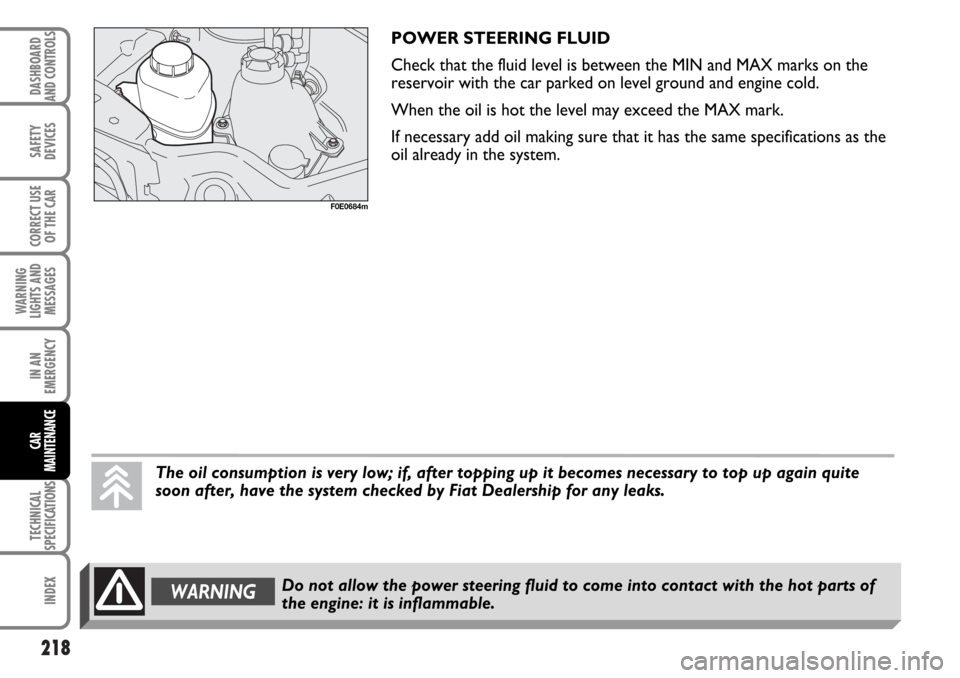
218
SAFETY
DEVICES
CORRECT USE
OF THE CAR
WARNING
LIGHTS AND
MESSAGES
IN AN
EMERGENCY
TECHNICAL
SPECIFICATIONS
INDEX
DASHBOARD
AND CONTROLS
CAR
MAINTENANCE
POWER STEERING FLUID
Check that the fluid level is between the MIN and MAX marks on the
reservoir with the car parked on level ground and engine cold.
When the oil is hot the level may exceed the MAX mark.
If necessary add oil making sure that it has the same specifications as the
oil already in the system.
F0E0684m
The oil consumption is very low; if, after topping up it becomes necessary to top up again quite
soon after, have the system checked by Fiat Dealership for any leaks.
WARNINGDo not allow the power steering fluid to come into contact with the hot parts of
the engine: it is inflammable.
Page 222 of 266
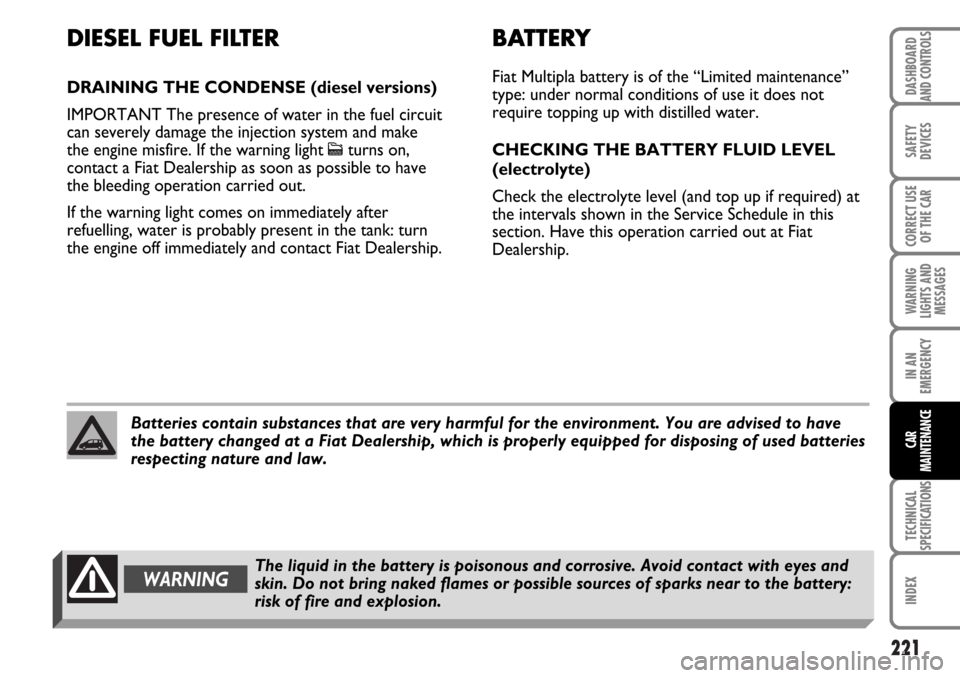
221
SAFETY
DEVICES
CORRECT USE
OF THE CAR
WARNING
LIGHTS AND
MESSAGES
TECHNICAL
SPECIFICATIONS
INDEX
DASHBOARD
AND CONTROLS
IN AN
EMERGENCY
CAR
MAINTENANCE
DIESEL FUEL FILTER
DRAINING THE CONDENSE (diesel versions)
IMPORTANT The presence of water in the fuel circuit
can severely damage the injection system and make
the engine misfire. If the warning light
cturns on,
contact a Fiat Dealership as soon as possible to have
the bleeding operation carried out.
If the warning light comes on immediately after
refuelling, water is probably present in the tank: turn
the engine off immediately and contact Fiat Dealership.
BATTERY
Fiat Multipla battery is of the “Limited maintenance”
type: under normal conditions of use it does not
require topping up with distilled water.
CHECKING THE BATTERY FLUID LEVEL
(electrolyte)
Check the electrolyte level (and top up if required) at
the intervals shown in the Service Schedule in this
section. Have this operation carried out at Fiat
Dealership.
Batteries contain substances that are very harmful for the environment. You are advised to have
the battery changed at a Fiat Dealership, which is properly equipped for disposing of used batteries
respecting nature and law.
The liquid in the battery is poisonous and corrosive. Avoid contact with eyes and
skin. Do not bring naked flames or possible sources of sparks near to the battery:
risk of fire and explosion.WARNING
Page 224 of 266
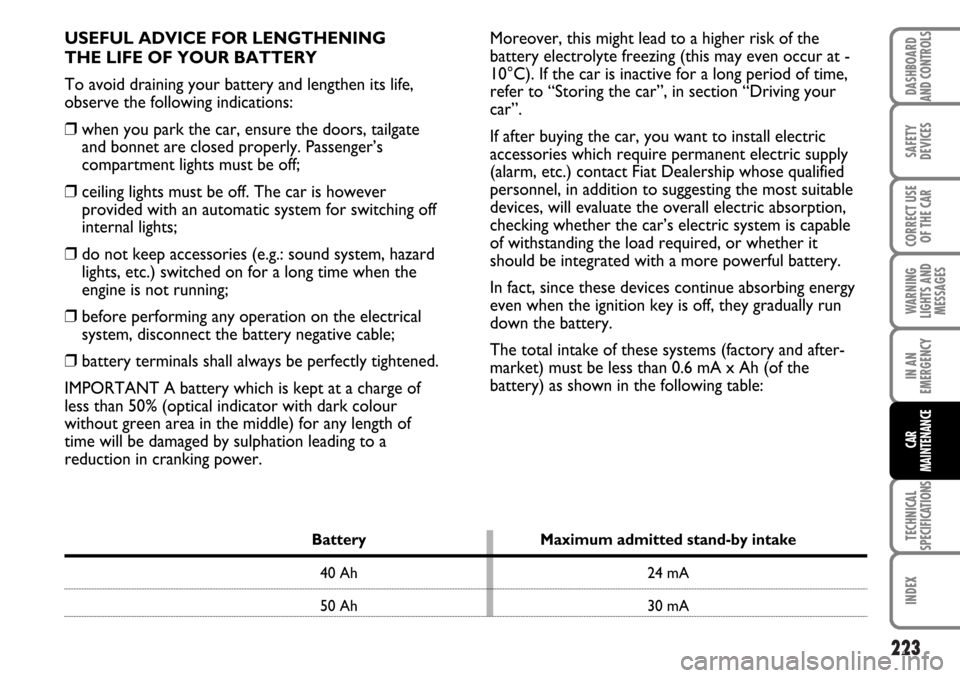
223
SAFETY
DEVICES
CORRECT USE
OF THE CAR
WARNING
LIGHTS AND
MESSAGES
TECHNICAL
SPECIFICATIONS
INDEX
DASHBOARD
AND CONTROLS
IN AN
EMERGENCY
CAR
MAINTENANCE
USEFUL ADVICE FOR LENGTHENING
THE LIFE OF YOUR BATTERY
To avoid draining your battery and lengthen its life,
observe the following indications:
❒when you park the car, ensure the doors, tailgate
and bonnet are closed properly. Passenger’s
compartment lights must be off;
❒ceiling lights must be off. The car is however
provided with an automatic system for switching off
internal lights;
❒do not keep accessories (e.g.: sound system, hazard
lights, etc.) switched on for a long time when the
engine is not running;
❒before performing any operation on the electrical
system, disconnect the battery negative cable;
❒battery terminals shall always be perfectly tightened.
IMPORTANT A battery which is kept at a charge of
less than 50% (optical indicator with dark colour
without green area in the middle) for any length of
time will be damaged by sulphation leading to a
reduction in cranking power.Moreover, this might lead to a higher risk of the
battery electrolyte freezing (this may even occur at -
10°C). If the car is inactive for a long period of time,
refer to “Storing the car”, in section “Driving your
car”.
If after buying the car, you want to install electric
accessories which require permanent electric supply
(alarm, etc.) contact Fiat Dealership whose qualified
personnel, in addition to suggesting the most suitable
devices, will evaluate the overall electric absorption,
checking whether the car’s electric system is capable
of withstanding the load required, or whether it
should be integrated with a more powerful battery.
In fact, since these devices continue absorbing energy
even when the ignition key is off, they gradually run
down the battery.
The total intake of these systems (factory and after-
market) must be less than 0.6 mA x Ah (of the
battery) as shown in the following table:
Battery Maximum admitted stand-by intake
40 Ah 24 mA
50 Ah 30 mA
Page 232 of 266
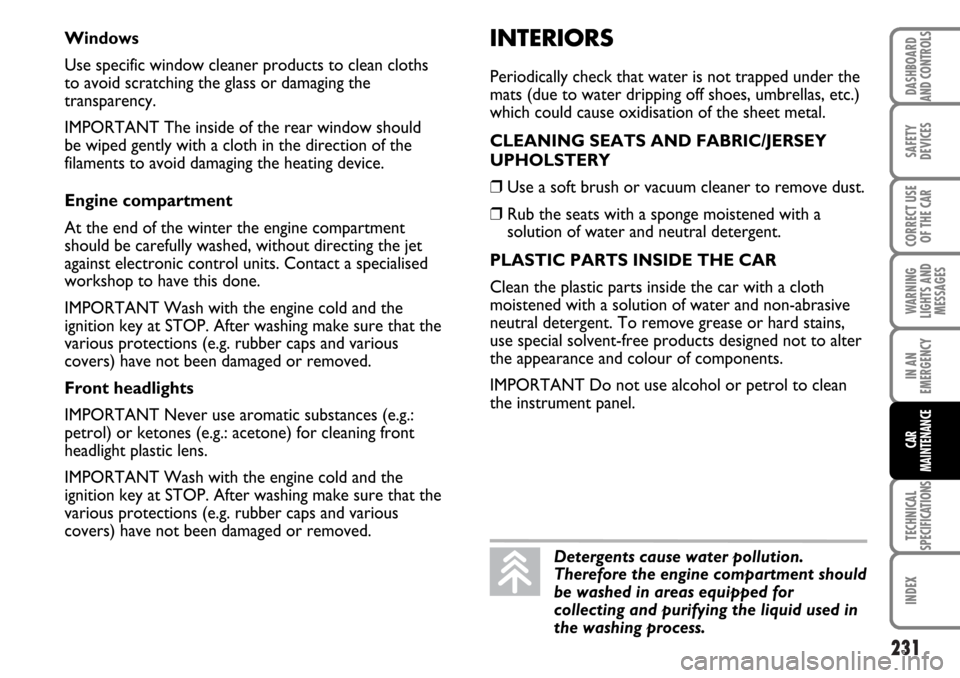
231
SAFETY
DEVICES
CORRECT USE
OF THE CAR
WARNING
LIGHTS AND
MESSAGES
TECHNICAL
SPECIFICATIONS
INDEX
DASHBOARD
AND CONTROLS
IN AN
EMERGENCY
CAR
MAINTENANCE
Windows
Use specific window cleaner products to clean cloths
to avoid scratching the glass or damaging the
transparency.
IMPORTANT The inside of the rear window should
be wiped gently with a cloth in the direction of the
filaments to avoid damaging the heating device.
Engine compartment
At the end of the winter the engine compartment
should be carefully washed, without directing the jet
against electronic control units. Contact a specialised
workshop to have this done.
IMPORTANT Wash with the engine cold and the
ignition key at STOP. After washing make sure that the
various protections (e.g. rubber caps and various
covers) have not been damaged or removed.
Front headlights
IMPORTANT Never use aromatic substances (e.g.:
petrol) or ketones (e.g.: acetone) for cleaning front
headlight plastic lens.
IMPORTANT Wash with the engine cold and the
ignition key at STOP. After washing make sure that the
various protections (e.g. rubber caps and various
covers) have not been damaged or removed.INTERIORS
Periodically check that water is not trapped under the
mats (due to water dripping off shoes, umbrellas, etc.)
which could cause oxidisation of the sheet metal.
CLEANING SEATS AND FABRIC/JERSEY
UPHOLSTERY
❒Use a soft brush or vacuum cleaner to remove dust.
❒Rub the seats with a sponge moistened with a
solution of water and neutral detergent.
PLASTIC PARTS INSIDE THE CAR
Clean the plastic parts inside the car with a cloth
moistened with a solution of water and non-abrasive
neutral detergent. To remove grease or hard stains,
use special solvent-free products designed not to alter
the appearance and colour of components.
IMPORTANT Do not use alcohol or petrol to clean
the instrument panel.
Detergents cause water pollution.
Therefore the engine compartment should
be washed in areas equipped for
collecting and purifying the liquid used in
the washing process.
Page 257 of 266
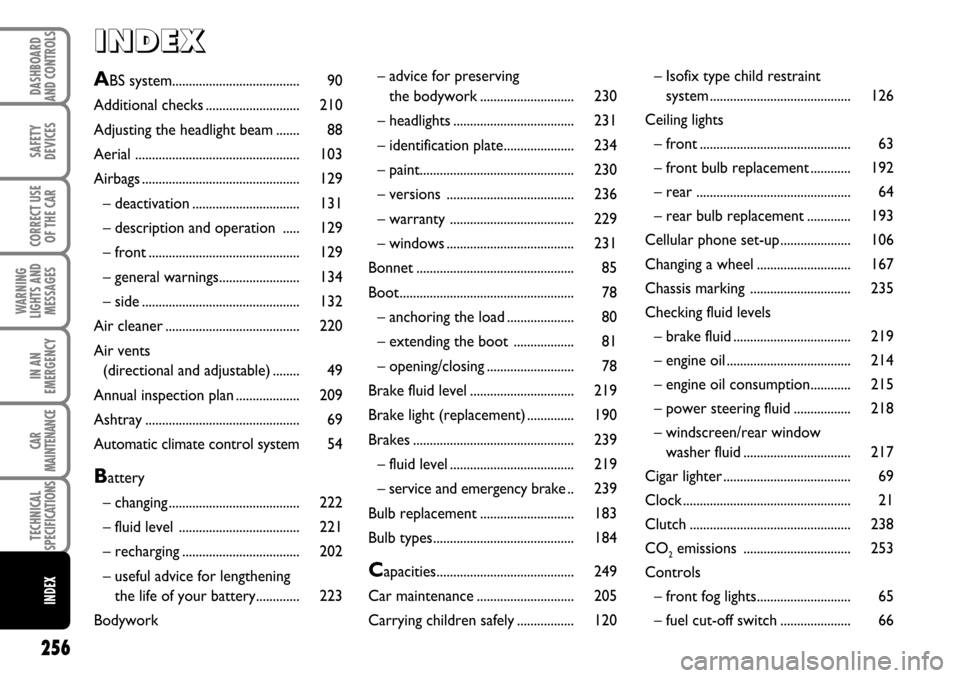
TECHNICAL
SPECIFICATIONS
256
SAFETY
DEVICES
CORRECT USE
OF THE CAR
WARNING
LIGHTS AND
MESSAGES
CAR
MAINTENANCE
INDEXDASHBOARD
AND CONTROLS
IN AN
EMERGENCY
I I
N N
D D
E E
X X
– Isofix type child restraint
system .......................................... 126
Ceiling lights
– front ............................................. 63
– front bulb replacement ............ 192
– rear .............................................. 64
– rear bulb replacement ............. 193
Cellular phone set-up ..................... 106
Changing a wheel ............................ 167
Chassis marking .............................. 235
Checking fluid levels
– brake fluid ................................... 219
– engine oil ..................................... 214
– engine oil consumption............ 215
– power steering fluid ................. 218
– windscreen/rear window
washer fluid ................................ 217
Cigar lighter ...................................... 69
Clock .................................................. 21
Clutch ................................................ 238
CO
2emissions ................................ 253
Controls
– front fog lights............................ 65
– fuel cut-off switch ..................... 66 – advice for preserving
the bodywork ............................ 230
– headlights .................................... 231
– identification plate..................... 234
– paint.............................................. 230
– versions ...................................... 236
– warranty ..................................... 229
– windows ...................................... 231
Bonnet ............................................... 85
Boot.................................................... 78
– anchoring the load .................... 80
– extending the boot .................. 81
– opening/closing .......................... 78
Brake fluid level ............................... 219
Brake light (replacement) .............. 190
Brakes ................................................ 239
– fluid level ..................................... 219
– service and emergency brake .. 239
Bulb replacement ............................ 183
Bulb types.......................................... 184
Capacities......................................... 249
Car maintenance ............................. 205
Carrying children safely ................. 120
ABS system...................................... 90
Additional checks ............................ 210
Adjusting the headlight beam ....... 88
Aerial ................................................. 103
Airbags ............................................... 129
– deactivation ................................ 131
– description and operation ..... 129
– front ............................................. 129
– general warnings........................ 134
– side ............................................... 132
Air cleaner ........................................ 220
Air vents
(directional and adjustable) ........ 49
Annual inspection plan ................... 209
Ashtray .............................................. 69
Automatic climate control system 54
Battery
– changing ....................................... 222
– fluid level .................................... 221
– recharging ................................... 202
– useful advice for lengthening
the life of your battery............. 223
Bodywork
Page 258 of 266

TECHNICAL
SPECIFICATIONS
257
SAFETY
DEVICES
CORRECT USE
OF THE CAR
WARNING
LIGHTS AND
MESSAGES
CAR
MAINTENANCE
INDEX
DASHBOARD
AND CONTROLS
IN AN
EMERGENCY
– hazard lights................................ 65
– heated rear window ................. 65
– rear fog lights ............................. 65
Consumption
– engine oil ..................................... 215
– fuel ................................................ 252
Current sockets .............................. 70
Dashboard ....................................... 5
Demisting/defrosting................ 51-53-55
– rear window ............................... 51-53
– windscreen and windows ..... 51-53
Diesel fuel filter ............................... 221
Differential ........................................ 238
Dimensions ....................................... 244
Dipped beam headlights
– bulb replacement ...................... 187
– control ......................................... 59
Direction indicators
– control ......................................... 60
– front bulb replacement ............ 188
– rear bulb replacement ............. 190
– side bulb replacement .............. 188
Doors
– child safety device ..................... 75
– opening/closing .......................... 74
Fiat Code (system) ........................ 8
FIX & GO automatic
(quick tyre repair kit) .................. 175
Fluids and lubricants ....................... 250
Front fog lights ................................. 65
– bulb replacement ..................... 187
– control ......................................... 65
Fuel
– consumption ............................. 252
– fuel cut-off switch .................... 66
– gauge ........................................... 18
Fuel filler cap .................................... 108
Fuses replacement .......................... 194
Gearbox
– type............................................... 238
– use ............................................... 142
Glove compartments/oddment trays
– driver's side ................................ 67
– passenger's side ........................ 67
– under seat .................................. 68
– under sun visors ........................ 68
Handbrake ....................................... 141
Hazard lights .................................... 65
Headlights.......................................... 88
– adjusting the headlight beam .. 88
Electric windows ............................ 76
– front ............................................. 76
– rear ............................................... 77
Electrically controlled sunroof ..... 72
– controls ....................................... 73
– roof closure safety system ...... 72
Electronic alarm............................... 11
– deactivation ................................ 13
– operation .................................... 11
– programming .............................. 12
– self-test ........................................ 12
– when alarm is triggered ........... 14
Engine
– identification code..................... 236
– marking ........................................ 235
– technical data ............................. 237
Engine codes ..................................... 236
Engine coolant level ........................ 216
Engine compartment (washing) .... 231
Engine oil
– checking level ............................. 214
– consumption............................... 215
– specifications .............................. 249
EOBD system ................................... 96
ESP (system) ..................................... 92